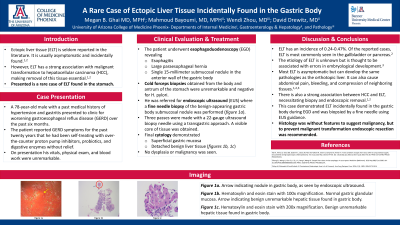Back


Poster Session E - Tuesday Afternoon
Category: Stomach
E0718 - A Rare Case of Ectopic Liver Tissue Incidentally Found in the Gastric Body
Tuesday, October 25, 2022
3:00 PM – 5:00 PM ET
Location: Crown Ballroom

Has Audio

Megan B. Ghai, MD, MPH, MA
University of Arizona College of Medicine, Banner University Medical Center
Phoenix, AZ
Presenting Author(s)
Megan B. Ghai, MD, MPH, MA1, Mahmoud Bayoumi, MD, MPH2, Wendi Zhou, MD, PhD2, David Drewitz, MD3
1University of Arizona College of Medicine, Banner University Medical Center, Phoenix, AZ; 2University of Arizona College of Medicine, Phoenix, AZ; 3Arizona Digestive Health, Phoenix, AZ
Introduction: Ectopic liver tissue (ELT) is seldom reported in the literature. It is usually asymptomatic and incidentally found. However, ELT has a strong association with malignant transformation to hepatocellular carcinoma (HCC), making removal of this tissue essential. Presented is a rare case of ELT found in the stomach.
Case Description/Methods: A 78-year-old male with a past medical history of hypertension and gastritis presented to clinic for worsening gastroesophageal reflux disease (GERD) over the past six months. The patient reported GERD symptoms for the past twenty years that he had been self-treating with over-the-counter proton pump inhibitors, probiotics, and digestive enzymes without relief. On presentation his vitals, physical exam, and blood work were unremarkable. The patient underwent esophagoduodenoscopy (EGD) which revealed esophagitis, a large paraesophageal hernia, and a single 15-millimeter submucosal nodule in the anterior wall of the gastric body. Cold forceps biopsies obtained from the body and antrum of the stomach were unremarkable and negative for H. pylori. He was referred for endoscopic ultrasound (EUS), where a fine needle biopsy of the benign-appearing gastric body submucosal nodule was performed (figure 1a). Three passes were made with a 22-gauge ultrasound biopsy needle using a transgastric approach. A visible core of tissue was obtained. Final cytology demonstrated superficial gastric mucosa and detached benign liver tissue (figures 1b, 1c). No dysplasia or malignancy was seen.
Discussion: ELT has an incidence of 0.24-0.47%. Of the reported cases, ELT is most commonly seen in the gallbladder or pancreas. The etiology of ELT is unknown but is thought to be associated with errors in embryological development. Most ELT is asymptomatic but can develop the same pathologies as the orthotopic liver. It can also cause abdominal pain, bleeding, and compression of neighboring tissues. There is also a strong association between HCC and ELT, necessitating biopsy and endoscopic removal. This case demonstrated ELT incidentally found in the gastric body during EGD and was biopsied by a fine needle using EUS guidance. Histology was without features to suggest malignancy, but to prevent malignant transformation endoscopic resection was recommended.

Disclosures:
Megan B. Ghai, MD, MPH, MA1, Mahmoud Bayoumi, MD, MPH2, Wendi Zhou, MD, PhD2, David Drewitz, MD3. E0718 - A Rare Case of Ectopic Liver Tissue Incidentally Found in the Gastric Body, ACG 2022 Annual Scientific Meeting Abstracts. Charlotte, NC: American College of Gastroenterology.
1University of Arizona College of Medicine, Banner University Medical Center, Phoenix, AZ; 2University of Arizona College of Medicine, Phoenix, AZ; 3Arizona Digestive Health, Phoenix, AZ
Introduction: Ectopic liver tissue (ELT) is seldom reported in the literature. It is usually asymptomatic and incidentally found. However, ELT has a strong association with malignant transformation to hepatocellular carcinoma (HCC), making removal of this tissue essential. Presented is a rare case of ELT found in the stomach.
Case Description/Methods: A 78-year-old male with a past medical history of hypertension and gastritis presented to clinic for worsening gastroesophageal reflux disease (GERD) over the past six months. The patient reported GERD symptoms for the past twenty years that he had been self-treating with over-the-counter proton pump inhibitors, probiotics, and digestive enzymes without relief. On presentation his vitals, physical exam, and blood work were unremarkable. The patient underwent esophagoduodenoscopy (EGD) which revealed esophagitis, a large paraesophageal hernia, and a single 15-millimeter submucosal nodule in the anterior wall of the gastric body. Cold forceps biopsies obtained from the body and antrum of the stomach were unremarkable and negative for H. pylori. He was referred for endoscopic ultrasound (EUS), where a fine needle biopsy of the benign-appearing gastric body submucosal nodule was performed (figure 1a). Three passes were made with a 22-gauge ultrasound biopsy needle using a transgastric approach. A visible core of tissue was obtained. Final cytology demonstrated superficial gastric mucosa and detached benign liver tissue (figures 1b, 1c). No dysplasia or malignancy was seen.
Discussion: ELT has an incidence of 0.24-0.47%. Of the reported cases, ELT is most commonly seen in the gallbladder or pancreas. The etiology of ELT is unknown but is thought to be associated with errors in embryological development. Most ELT is asymptomatic but can develop the same pathologies as the orthotopic liver. It can also cause abdominal pain, bleeding, and compression of neighboring tissues. There is also a strong association between HCC and ELT, necessitating biopsy and endoscopic removal. This case demonstrated ELT incidentally found in the gastric body during EGD and was biopsied by a fine needle using EUS guidance. Histology was without features to suggest malignancy, but to prevent malignant transformation endoscopic resection was recommended.

Figure: Image 1a. Arrow indicating nodule in gastric body, as seen by endoscopic ultrasound.
Image 1b. Hematoxylin and eosin stain with 100x magnification. Normal gastric glandular mucosa. Arrow indicating benign unremarkable hepatic tissue found in gastric body.
Image 1c. Hematoxylin and eosin stain with 200x magnification. Benign unremarkable hepatic tissue found in gastric body.
Image 1b. Hematoxylin and eosin stain with 100x magnification. Normal gastric glandular mucosa. Arrow indicating benign unremarkable hepatic tissue found in gastric body.
Image 1c. Hematoxylin and eosin stain with 200x magnification. Benign unremarkable hepatic tissue found in gastric body.
Disclosures:
Megan Ghai indicated no relevant financial relationships.
Mahmoud Bayoumi indicated no relevant financial relationships.
Wendi Zhou indicated no relevant financial relationships.
David Drewitz indicated no relevant financial relationships.
Megan B. Ghai, MD, MPH, MA1, Mahmoud Bayoumi, MD, MPH2, Wendi Zhou, MD, PhD2, David Drewitz, MD3. E0718 - A Rare Case of Ectopic Liver Tissue Incidentally Found in the Gastric Body, ACG 2022 Annual Scientific Meeting Abstracts. Charlotte, NC: American College of Gastroenterology.
